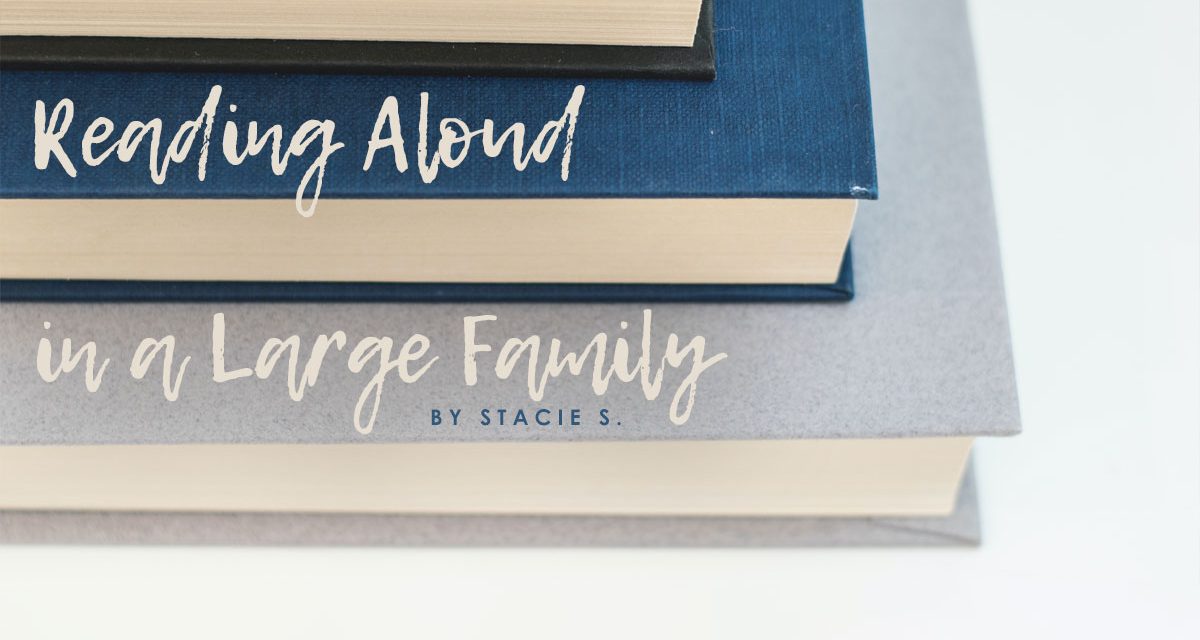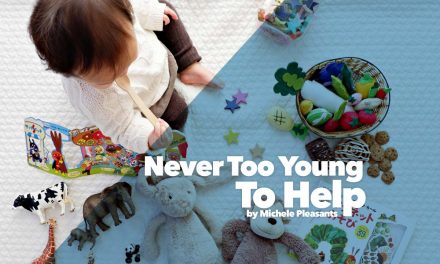Reading aloud isn’t a brand new homeschooling idea, but even so, it is worth mentioning a few details about it.
Most mamas have in mind that reading aloud time will occur with all the kiddos snuggled up on the couch together, warm blankets and fuzzy socks, the glow of a fire in the fireplace and a favorite snack and cup of tea. Some days are actually just like that. Then, there are days when the baby can’t get settled, the toddler won’t sit still, and the kids are talking to each other, and no one cares that you are reading aloud.
Most of my read aloud time is somewhere in the middle, though, and we are able to have some really, good, solid read aloud days. Here is how I have learned to find balance in reading aloud to my large family .
Timing
I carefully select a time when I know that my children are eager and more willing to listen. One such time is during snack times or lunch. Because their precious little mouths are busy chewing, my children aren’t busy talking, which allows me to get in a good bit of reading.
Another time is right at the beginning of our daily nap/quiet time. {This downtime time has been a staple in our home for almost 18 years now. My older kids now use this time for a “study hall” or to pursue a personal interest–preferably a quiet one!} I get comfy in the upstairs hallway which is sort of a central location to the bedrooms and to the dining area below, where my older children are usually working.
One last favorite is to motivate the kids to finish up their bookwork for an unplanned read-aloud at the end of our school day. I use this on days when they are dragging their feet (or when mama is dragging her feet) and it is an instant mood booster.
Minimal Activities
My children have to be doing very little in order for our read aloud to be a success. I’ve seen other mothers talk about all the different quiet activities they allow their children to do while they read, things like puzzles, play-doh, or building blocks. That just doesn’t work for my little ones. It never fails; they end up engrossed in what they are doing, rather than listening to the story. Then the next time I read, they have no clue what I’ve read before and can’t enjoy the story because they’ve missed important details.
Occasionally, I will give the younger children pictures to color about what I’m reading and that has helped them to focus on the story. {Or, as I mentioned above, a little something to snack on also helps them to settle down.} My older girls will sometimes draw or craft while I read. Overall, what works best for us is just plain listening.
I am trying to cultivate a healthy ability to listen well and to draw key elements out of what is read aloud. I think this is an extremely skill that is useful for all sorts of situations in life. To help train the ear, I am sure to slow my pace enough to read with expression and with variation in tone, which my kids really appreciate. They can grasp the story and its meaning easier.
Older Children
Include your older children in read alouds, too! Many think that once a child is reading proficiently on his own, that reading aloud is not necessary. Some exclude the older children and leave the reading aloud to the little ones only. While it may be true that teens don’t need mama to read to them, there’s still a benefit to doing so.
I typically select books for my younger children that were once favorites of my older children. When I read these books aloud to my little ones, my teens are usually present (we sort of function like a one-room school house) and it allows sweet memories to resurface for my teens. Listening to these stories again provides them with another way they can connect with the younger children.
There are still times when I intentionally read aloud to all of my children (8 children, ages 17 months to 17 years), which means it can be challenging to find something that interests the entire group. The best books for my large group are those that hit middle-of-the road in terms of reading level/ability and comprehension. I’ve found these books are usually ones about a group of children, some sort of adventure, or both. All of the children immediately identify themselves or each other in some aspect of the characters. Reading aloud is another way to strengthen family ties.
Final Thoughts
There is something special about the spoken word. Hearing words read aloud not only train the ears in listening skills and reinforce comprehension, but it increases the appreciation for language. Carefully choosing words to communicate an idea, the rhythm of words playing upon each other, learning definitions or new ways to use a word, the proper context and grammatical structure of a sentence, the development of thought or plot –all of these sorts of things can be “taught” through reading aloud without ever having to call it a formal lesson. Then, what is heard will spill over into the way children speak, read and write. Win-win!





